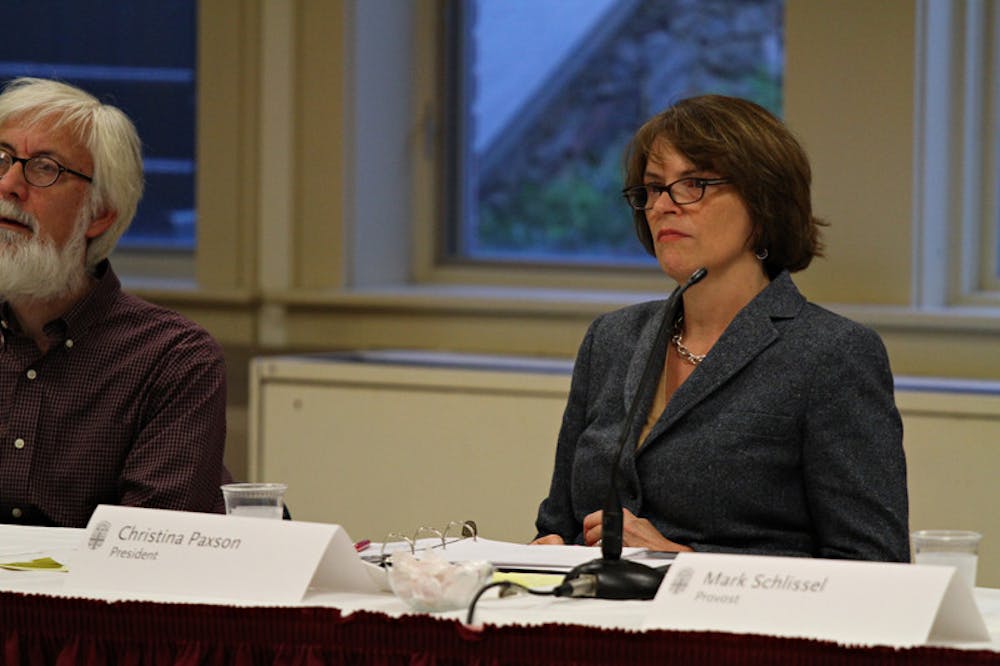Administrators addressed potential concerns regarding President Christina Paxson’s strategic plan at the Brown University Community Council meeting Wednesday evening.
Provost Mark Schlissel P’15 presented on various aspects of the strategic plan, including financial aid, diversity, the humanities and the size of the University. Schlissel addressed the plan’s length, saying “we mercifully worked hard to make it relatively short” and adding that the plan is “a distillation of the ideas that percolated up” from various exploratory and advising committees over the past year.
“There’s a lot of work to be done on fleshing out these themes,” Schlissel said of the plan’s central proposals, which do not include specifics on how or when particular goals in the plan will be enacted.
“The idea of coming up with a detailed roadmap” does not “make sense,” Schlissel said at the meeting, adding that such a plan “would become stale.” Outlining a precise course of action for a 10-year period may not allow for flexibility in response to changes, Schlissel said, citing examples such as technological and economic developments over the past decade.
He also cited the current federal government shutdown as an example of how changing conditions may affect broader goals like universal need-blind admission.
“We call this a 10-year plan — it’s probably much more than a 10-year plan,” Schlissel said.
Kiera Peltz ’16, the Undergraduate Council of Students’ communications chair and a former Herald staff writer, said at the meeting that she was disconcerted by the plan’s emphasis on developing the University’s graduate student programs when financial need for undergraduates could still be improved.
“We know we have to work hard on financial aid for middle-class students,” Paxson said, adding that she “doesn’t like the idea” of failing to balance potentially competing priorities such as financial aid and graduate program development.
“If we want to do new things, we need new money,” Schlissel said, adding that “tuition is already extremely high.”
Paxson noted that “a lot of those costs are baked into the budget,” and it would not be possible to cut tuition “without causing serious harm.”
Financial aid is the “fastest growing” item in the University’s budget, Schlissel said, adding that increases should be carefully considered in conjunction with other priorities — for instance, ensuring that the quality of teaching is maintained and that “once you’re here, you’re getting a world-class education.”
“You can’t be excellent without being diverse,” Schlissel said, adding that diversity did not receive its own section in the plan because it is incorporated throughout.
“If we literally stay the same, we’re falling behind” peer institutions, Schlissel said. Because of the University’s lesser resources in comparison to peers, collaboration will be an important goal in coming years, Schlissel said, adding, “our hospital partners are really critical to the success of our medical school.”
The plan does not seek to disrupt the balance of different communities on campus, such as undergraduates and graduate students, Schlissel said. “As long as we don’t interfere with the quality of teaching,” modestly growing the student body in coming years will be a positive development, he said.
Schlissel said physical upgrades to the campus are essential because “as the modes of teaching change,” it will be important to have “different kinds of interactive learning” made possible by diverging from the traditional lecture classroom setup.
Linford Fisher, assistant professor of history, said at the meeting it was unclear why there was not more of an emphasis on the humanities in the plan. Paxson responded by citing statistics of new faculty hires in the past year that she said “were not skewed towards the (science, technology, engineering and mathematics) discipline.”
Of faculty members hired for the 2012-13 academic year, 30 percent were in the humanities, 30 percent in the social sciences, 24 percent in the physical sciences and 16 percent in the life sciences, The Herald previously reported.
“Big science needs big buildings,” Paxson said, adding that though STEM fields may seem to have a larger presence on campus, that perception is not necessarily accurate.
Paxson added that though humanities may not appear to be a priority in the plan, “it is not biased towards STEM.”
“We do not want to become Brown technical school,” she added.
Faculty members have expressed concern because the draft does not use the phrase “university-college,” The Herald previously reported. Paxson said at the meeting she was “happy” to put the language back into the plan, but its absence does not indicate a desire to change the nature of the community.
“The strategic plan has just been very vague,” said Mika Zacks ’15, a former Herald opinions columnist, who said she attended the meeting to better understand the plan. “I just wanted to hear more,” she said.
Russell Carey ’91 MA ’06, executive vice president for planning and policy, briefly presented on plans for the campus safety task force. Though it has “just been formed,” it will be meeting shortly and will deliver a report of recommendations regarding safety on campus to Paxson in December.

ADVERTISEMENT




